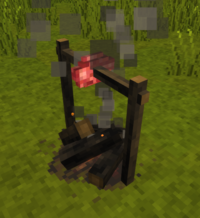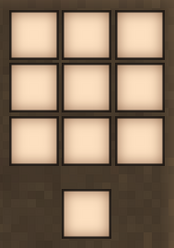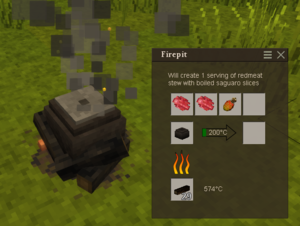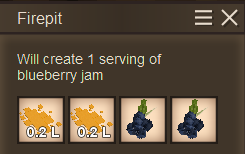Кулинария
Nutrition and Satiation
Current nutrition and satiety levels can be examined in the character dialog, mapped to 'C' by default.
Satiety
Player satiety is how hungry a player is - or how many calories are still available to burn, if you will. It is represented by the green bar on the righthand side above the hotbar, and has a maximum value of 1500. Satiety will decrease naturally over time, even if the player is AFK; but certain actions (such as sprinting), certain pieces of equipment (such as most armor), or certain conditions (such as regenerating lost health) will increase consumption over this passive rate. If satiety drops to zero, the player will begin starving, taking damage over time until death occurs. Eating any food restores satiety as shown in the item's tooltip.
Nutrition
Where satiety is the basic survival condition, nutrition is a way to gain bonuses by eating a variety of different foods instead of just relying on the same thing all day, every day. Player nutrition includes four categories, displayed in the character dialog: protein, vegetable, grain, and fruit. Gaining satiety from eating any food also increases the bar for the nutrient group that the food belonged to. Meals cooked from multiple ingredients can increase multiple nutrient levels at the same time. Like satiety, nutrient levels decrease over time. Keeping all four nutrient levels topped up requires a balanced diet.
As the nutrient bars fill up, the player's maximum health increases. The player starts with 15 base health points at default settings, and each nutrient can add another 2.5 hp when fully satisfied, for a total of up to 10 bonus hp in total. This bonus is very useful when exploring the deepest reaches of the world, where very dangerous creatures roam.
Basic Foods
At the start of the game, without any infrastructure, the player only has access to a small variety of foraged or hunted food that can be eaten raw. However, the player should not rely on these for overly long, as once harvested, naturally occuring foodstuffs are either gone for good, or require a long time to regrow.
The following table lists all the food items that can be eaten raw:
| Item | Satiety | Category | Notes |
|---|---|---|---|
| Cranberries | 60 | Fruit | |
| Blueberries and currants* | 80 | Fruit | |
| Honey bowl* | 60 | Fruit | Crafted. Restores 0.5 hp upon consumption. |
| Saguaro fruit | 60 | Fruit | Restores 1 hp upon consumption. |
| Flax grain | 30 | Grain | |
| Rice, rye, or spelt grain | 60 | Grain | |
| Boletes and field mushrooms | 80 | Vegetable | |
| Fly agaric mushroom | 80 | Vegetable | Deals 10 hp damage (!) upon consumption. |
| Carrots, onions, parsnips, turnips | 100 | Vegetable | |
| Cabbage | 300 | Vegetable | |
| Pumpkin, slice | 120 | Vegetable | Crafted. |
| Pumpkin, whole | 480 | Vegetable | |
| Lump of fat | 200 | Protein | |
| Vintage Beef | 280 | Protein | Rare ruin loot. Restores 2 hp upon consumption. |
- Currants include black currant, red currant, and white currant berries.
- In order to make honey bowls, the player must get into beekeeping.
Basic Cooking
The first opportunity for making better food comes with the firepit. A small number of foraged or hunted ingredients can be placed directly into it for processing. Additionally, it is used for baking dough into bread.
The following table lists all the food items that can be processed in the firepit:
| Item | Satiety | Category | Notes |
|---|---|---|---|
| Cooked bushmeat | 120 | Protein | |
| Cooked redmeat | 280 | Protein | |
| Cooked poultry | 200 | Protein | |
| Cooked egg | 160 | Protein | Recipe currently defunct. |
| Cooked cattail root | 100 | Vegetable | |
| Flax bread | 160 | Grain | Crafted. |
| Rye or spelt bread | 300 | Grain | Crafted. |
| Rice bread | 330 | Grain | Crafted. |
Making Bread
Despite the deceptively simple baking process, making bread requires some setup in order to produce the dough. A bucket and a quern must be available, both of which require metal tools to craft. Additionally, a farm is required to consistently supply useful amounts of grain, as wild crops are nonrenewable, mature extremely slowly, and are susceptible to being eaten by animals.
In return, bread is one of the best ways to process grains that exists in the game, with an at least five-fold yield multiplier compared to eating the raw grain.
To create bread dough, prepare flour using a quern to grind grain.
Open the quern GUI and add grain into the input slot on the left of the quern.
- Hold
interact on the top of the quern to grind the grain into flour, which will appear in the output slot on the right of the quern.
During later stages of the game, a windmill may be used to drive the quern.
- In the crafting grid, combine a bucket of water and flour to create dough. Each flour item will consume one unit of water from the bucket.
Advanced Cooking
Advanced cooking allows the player to make meals out of multiple ingredients, which can potentially supply multiple nutrition groups at he same time. Cooking increases the food values of all ingredients used, and provides additional benefits and convenience. A single pot can potentially contain thousands of satiety points; meals can be kept fresh for very long times in sealed crockpots; eating meals will outright halt satiety loss for a time; and the player will never waste any food from a meal when it provides more satiety than they need. Instead, they simply leave a partially-eaten serving that can be finished at a later time.
To begin, craft at least one bowl and one claypot using the clay forming mechanic, and fire them like all ceramics in a firepit. Placing the fired claypot into the fire pit input slot (upper left) will open up an additional four-slot inventory above the input slot, in which ingredients can be combined into one of the five available meal types. The meal type players create is determined by which two "required" ingredients are placed into the claypot first.
- To create one serving of any meal: place one of each required item into two separate claypot slots (this defines the meal type). For example, a porridge requires "two grain", so a player must add two individual pieces of grain in any two input slots in the claypot. Placing two grain in one input slot of the claypot will not create a porridge. Adding "optional" ingredients in the other two input slots of the claypot will increase the nutrition value and satiation of the meal depending on which items are added. When a valid meal recipe (combining correct ingredients) is placed into the input slots, a message will appear in the claypot dialog box informing players about what type of meal will be created after cooking.
- To cook multiple servings of a meal: increase the number of ingredient items added to all slots equally. The claypot allows players to cook up to 6 servings of any meal at a time. When creating multiple servings all the items in the input slots must be increased by the same amount, or the food will not cook!
- To fill a bowl: A bowl holds one meal portion and may be filled from a claypot or food storage crock. To fill a bowl, place the container of cooked food onto a solid surface. With the empty bowl in the active hand use RMB on the claypot or crock. Bowls and crocks may be filled with meals while the claypot is in the firepit. Bowls of food may be carried in player inventories, stored in stationary containers, and placed on shelves. Bowls cannot be filled from crocks on shelves.
- To eat a meal: Food may be consumed from a filled bowl. With the filled bowl in an active hotbar slot, eat using RMB. Players will eat until full, which may leave partial portions of food in the bowl.
- To store meals: Four portions of any cooked meal can be stored in an empty crock. Place the pot onto the ground or table and right click the pot with an empty crock to transfer meals to the storage crock. Storage crocks may be sealed for long term storage using fat or wax in the crafting grid, Crocks may also be carried in player inventories, stored in stationary containers, and placed on shelves.
Advanced Cooking Recipes
| Advanced Recipes | Meat Stew | Vegetable Stew | Porridge | Soup | Jam |
|---|---|---|---|---|---|
| Required Ingredients | 2 Poultry or Red meat | 2 Vegetables or Beans | 2 Grain | 1 Vegetable (Fresh) + 1 Water* | 2 Fruit + 2 Honey* |
| Optional Protein | 0 - 2 Poultry, Red meat, Egg or Beans | 0 - 2 Soy beans (pickled or fresh) | 0 - 1 Poultry, Red Meat or Egg | ||
| Optional Vegetable | 0 - 2 Vegetable (pickled or fresh) | 0 - 2 Vegetable (pickled or fresh) | 0 - 2 Vegetable (pickled or fresh) | 0 - 2 Vegetable (pickled or fresh) | |
| Optional Grain | 0 - 2 Grain | ||||
| Optional Fruit | 0 - 1 Fruit, Honey* | 0 - 2 Fruit | |||
| Optional Honey | 0 - 1 Honey* |
- Add water or honey with a filled bucket. Use LMB to add one portion, RMB to remove one portion.
Advanced Cooking Food Values
The satiation received from eating meals is equal to the sum of its parts. The ingredients added to create the meal determine how much satiation and which class of nutrition a player receives. In addition, the food values of most ingredients are increased via cooking, as shown in the table below. Only pickled ingredients remain unchanged, providing the same amount of value in a meal as they would when eaten individually.
Note: for every 100 satiation filled by consuming a meal, an additional 30 seconds passes before the player's satiety bar starts dropping again for any reason. Consuming a large meal can result in more than five minutes of completely free healing, sprinting, heavy armor wearing, or other strenuous tasks.
| Protein | Satiation in Meal | Vegetable | Satiation in Meal | Grain | Satiation in Meal | Fruit | Satiation in Meal |
|---|---|---|---|---|---|---|---|
| Soy Bean | 240 | Carrot, Parsnip, Onion, Turnip | 150 | Flax grain | 120 | Currants* | 120 |
| Egg | 200 | Cabbage | 450 | Rice grain | 280 | Blueberry | 120 |
| Poultry, cured or fresh | 375 | Pumpkin slice | 180 | Rye grain | 240 | Cranberry | 90 |
| Redmeat, cured or fresh | 420 | Pumpkin, whole | 720 | Spelt grain | 240 | Saguaro fruit | 90 |
| Mushrooms* (Bolete, Field, Fly agaric) | 120 | Honey | 80 |
- Ingredients not listed in this table cannot be used in meals. Pickled variants of listed ingredients can be used, but are worth less.
- Currants include black currant, red currant, and white currant berries.
- Mushrooms can only be secondary ingredients. They can be added to valid meals, but cannot make a valid meal themselves.
- Ingredients that restore player health when eaten raw, such as saguaro fruits or honey, lose this benefit when cooked.
However, cooking a fly agaric mushroom does not remove its harmful effects - the meal will still damage the player!
Видео Руководства
| Продвинутая Кулинария (не менялась с версиии 1.12) |
|---|
| {{{title}}} | |
|---|---|



